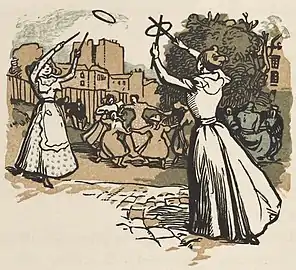Auguste-Louis Lepère
Auguste-Louis Lepère (30 November 1849 - 20 November 1918) was a French painter and etcher. Lepère is also considered a leader in the creative revival of wood engraving in Europe.

Biography
Auguste Louis Lepère was born in Paris. At the age of thirteen, he began his artistic education in the Paris studio of the engraver Joseph Burn-Smeeton. By the mid-1870s, Lepère had emerged as one of the most renowned printmakers of his time.[1]
Lepère focused mostly on daily life in both his etchings and wood engravings. He is now remembered for his innovations, such as the use of colored paper and the combining of etching and wood engraving on the same print. The last years of Lepère's life were given almost exclusively to wood engraving. In total, his graphic oeuvre consists of over 150 etchings, over 200 wood engravings and 14 lithographs.[1] He died at Domme, aged 68.
Works
- Works of Auguste-Louis Lepère
_(How_Quickly_Youth_Fades!_-_Jeunesse_passe_vite_vertu!)_MET_DP834391.jpg.webp) Laundresses (Blanchisseuses) - Soft-ground etching and aquatint; printed in three colors (1893)
Laundresses (Blanchisseuses) - Soft-ground etching and aquatint; printed in three colors (1893) Jeu des grâces dans la rue, illustration de Paysages et coins de rues de Jean Richepin
Jeu des grâces dans la rue, illustration de Paysages et coins de rues de Jean Richepin View of thefaçade of Rouen Cathedral, seen from the right, wood engraving- British Museum
View of thefaçade of Rouen Cathedral, seen from the right, wood engraving- British Museum The printer- estampe: Woodcut with hand coloring
The printer- estampe: Woodcut with hand coloring Storm on the Island of Yeu - Watercolor and gouache over black crayon. (1916)
Storm on the Island of Yeu - Watercolor and gouache over black crayon. (1916)
References
- "Auguste Louis Lepere Les Trophees". Retrieved 2012-05-29.
External links
| Wikimedia Commons has media related to Auguste Lepère. |